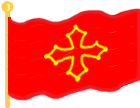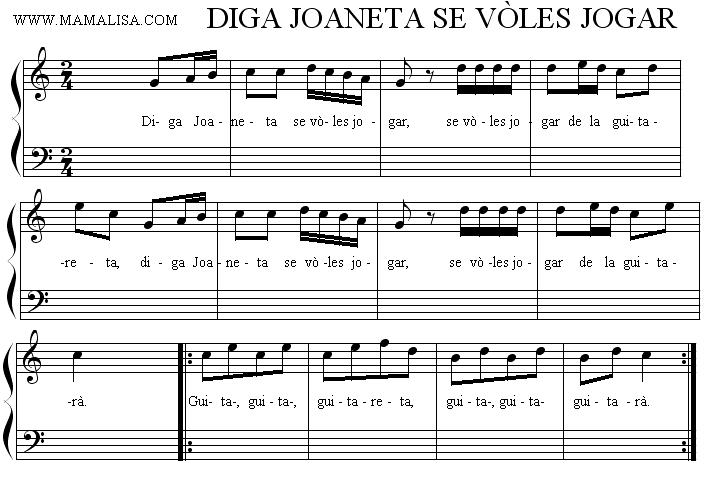Diga, Joaneta, se vòles jogar
Diga, Joaneta, se vòles jogar
Tell Us Dear Janet if You Want to Play
Children's Song
Children's Song
(Occitan)
(English)
Diga Joaneta se vòles jogar
Se vòles jogar de la guitareta
Diga Joaneta se vòles jogar
Se vòles jogar de la guitarà.
Guita-, guita-, guitareta,
Guita-, guita-, guitarà,
Guita-, guita-, guitareta,
Guita-, guita-, guitarà.
Diga Joaneta se vòles jogar
Se vòles jogar de la violoneta,
Diga Joaneta se vòles jogar
Se vòles jogar de la violonà.
Violo-, violo-, violoneta,
Violo-, violo-, violonà,
Violo-, violo-, violoneta,
Violo-, violo-, violonà.
Guita-, guita-, guitareta,
Guita-, guita-, guitarà,
Guita-, guita-, guitareta,
Guita-, guita-, guitarà.
Diga Joaneta se vòles jogar
Se vòles jogar de la....clarineta... castanheta... trompinheta... bodegueta... tontoneta... tamborneta... e totes los instruments de musica qu'òm vòl
Tell us dear Janet if you want to play,
If you to play the guitaret.
Tell us dear Janet if you want to play,
If you want to play the guitarah.
Guita-, guita-, guitaret,
Guita-, guita-, guitarah,
Guita-, guita-, guitaret,
Guita-, guita-, guitarah.
Tell us dear Janet if you want to play,
If you want to play the violinet.
Tell us dear Janet if you want to play,
If you want to play the violinah.
Violi-, violi-, violinet,
Violi-, violi-, violinah,
Violi-, violi-, violinet,
Violi-, violi-, violinah.
Guita-, guita-, guitaret,
Guita-, guita-, guitarah,
Guita-, guita-, guitaret,
Guita-, guita-, guitarah.
Tell us dear Janet if you want to play,
If you want to play the… clarinet… castanet… trumpet… bagpipet… and you can add any instrument and add an ending in "-et" and "-ah" to its name
Notes
The translation is singable.
The names of the instruments:
"Trompinheta" is based on the word "trompeta" meaning "trumpet".
"Bodegueta" is based on "bodega" which is a large bagpipe whose bag is a whole sheep skin.
"Tontoneta" is based on "ton-ton" which is a psaltery much in use in the West side of Occitania.
"Tamborneta" can be considered as based on "tamborn" which is a drum, or "tambornet" which is a tambourine.
Game Instructions
Couples Dance: 1st Measure: One polka step rightward (right foot, left, right ) for the lady.
2nd Measure: One polka step leftward (left, right, left) -the other way round for her partner.
2 next measures: turn (4 steps).
In a Row: 1 polka step rightward (right foot, left, right), 1 polka step leftward (left, right, left), 4 polka steps rightward, 1 polka step leftward (left, right, left), 1 polka step rightward (right, left, right), 4 polka steps leftward. Turn around clockwise on 4 measures, counterclockwise 4 measures - twice.
Comments
There's a slightly different version that goes "Diga-me joine òme…" ("Tell me, young man…").
This song can be sung as a cumulative song. It's also a dance song without the resuming of the instruments. The dance is called "Scottish" (also spelled "scotiche"). It can be danced as couples or individually in rows. The dance is actually of German or Hungarian origin but was called "Scottish" in France after WW I because of anti-German feelings among the people at that time.

Thanks and Acknowledgements
Many thanks to Monique Palomares for contributing and translating this song, the score, the midi and the mp3 music.
Mercé plan!


























